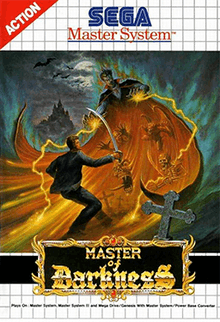Master of Darkness
| Master of Darkness | |
|---|---|
 Master of Darkness cover art | |
| Developer(s) | SIMS |
| Publisher(s) | Sega |
| Composer(s) |
Yoko Wada Takashi Horiguchi |
| Platform(s) |
Sega Master System Game Gear |
| Release |
Master System[1]
|
| Genre(s) | 2D action platformer |
| Mode(s) | Single player |
Master of Darkness (released as In the Wake of Vampire in Japan and Vampire: Master of Darkness[2] in the US), is a video game released for the Sega Game Gear and the Sega Master System. It was developed by SIMS.
Overview
Master of Darkness is a platform game, very similar to Castlevania. The plot has the player entering the role of an Ouija Board-playing psychologist named Dr. Ferdinand Social, who is looking to defeat Dracula, who is behind a series of killings in London which have been attributed to Jack the Ripper. However, Jack the Ripper is indeed responsible, for he is using the victim's bodies and fresh blood for sacrificial offerings - as part of a dark ritual being performed by Count Massen to resurrect Dracula. Also taking some part in the murders and the dark ritual is a mysterious Psychic Girl, who is possessed by an evil Skull Spirit.
The game requires the player to battle their way through five rounds, which are divided into three lengthy stages. The rounds consists of the Thames River, House of Wax, a Cemetery that leads to Count Massen's Castle, a Laboratory within Massen's Castle, and finally being teleported to a dungeon-like Labyrinth within Castle Dracula, which resides in a forest of Transylvania. At the end of each round is a boss, a person with connection to the murders and dark ritual who must be defeated. The bosses are Jack the Ripper, a Psychic Girl possessed by a Skull Spirit, Count Massen, performer of the rituals, and finally Dracula himself.
Enemies the player must battle include zombies, sharply-dressed gun-toting hooligans, bats, dogs, wolves, poltergeists possessing various decorations, skeleton knights, magical sword-wielding wizards, owls, and ghost maidens. To defeat the enemies, players can utilize several primary and secondary weapons. Primary weapons are close combat weapons ranging from knives, walking canes, rapiers and axes, that differ in range and efficiency. Secondary weapons are long-range weapons, which consists pistols, bombs, and boomerangs - with limited ammunition. The player can only possess one type of primary and secondary weapon. Picking up a new weapon means it automatically replaces the previous weapon in the player's inventory.
Reception
Both the Master System and Game Gear versions were well received critically, drawing particular praise for the detailed graphics and responsive controls. Another factor may be that the Castlevania series was yet to appear on a Sega console and Master of Darkness was the closest - in terms of quality and gameplay - that the Master System had come to replicating the experience.
Sega Force gave Master of Darkness a composite score of 79% between its two reviewers Mat Yeo and Paul Wooding. Mat rated it an 83% noting its visuals and Gothic atmosphere, while stating a few of the enemies could be annoying, particularly the dog. Paul gave the game a 74% stating the controls to be easy to use while considering the difficulty to be on the high side and the game play to occasionally be repetitive.[3]
See also
References
- ↑ "Master of Darkness". SegaPro (in German). June 1993. p. 57.
- 1 2 "Vampire: Master of Darkness Release Information for GameGear - GameFAQs". GameFAQs. 23 March 2009. Archived from the original on 23 March 2009.
- ↑ Yeo, Mat; Paul Wooding (December 1992). "Master of Darkness - review by Sega Force magazine". Sega Force (12): 74–75. Retrieved 26 September 2011.